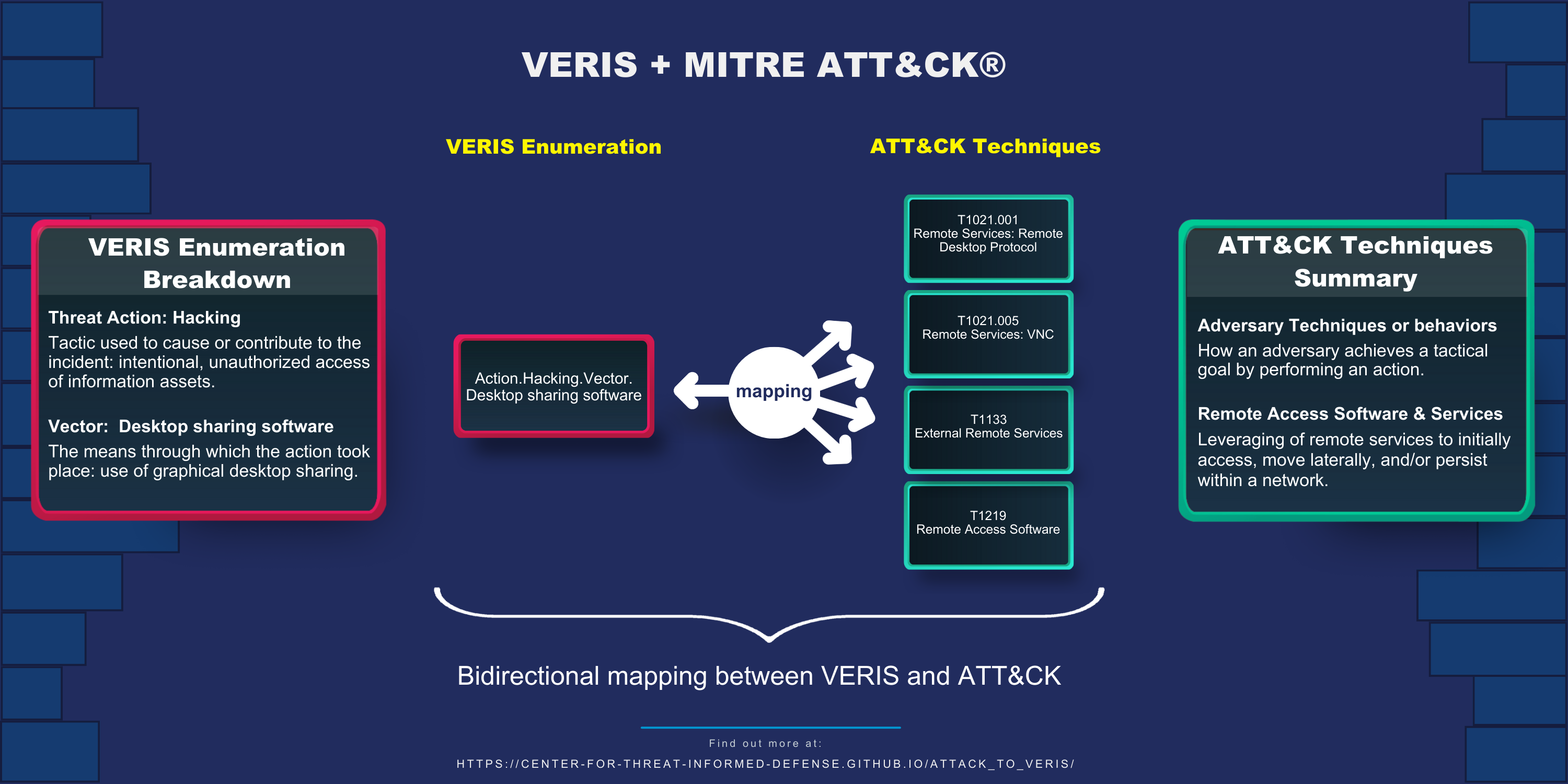Overview
To fully understand and document cybersecurity incidents requires two types of information: information about the organization, assets, and data targeted (the “who”, “what”, and “why”), as well as specifics on the tradecraft that the adversaries used to achieve their objectives (the “when” and “how”). Without the former, descriptions of incidents often lack important information that roughly translates into the “so what” — the true impact of the event. Without the latter, breach reports lack sufficient information to allow others to protect themselves from the threat.
To allow cyber professionals to better connect the who, what, and why (captured in VERIS) with the when and how (described in ATT&CK), the Center created a mapping and translation layer between VERIS and ATT&CK in 2021. This mapping layer allows analysts to describe the adversary behaviors observed in an incident coded in VERIS. This allows for a joint analysis of the information that ATT&CK describes well (the behaviors adversaries use to attack systems) alongside the incident demographics and metadata that VERIS describes well.
As of 2023, the Center has released and expanded and updated version of the original project. This work strengthens the connection between these frameworks to increase the community’s ability to pivot between incidents coded in VERIS and adversary behaviors described in ATT&CK.
Background
VERIS is a common representation and data model for describing the demographics, metadata, and some technical details about cybersecurity incidents. It is used, among other things, to generate the Verizon Data Breach Investigation Report (DBIR).
The MITRE ATT&CK® knowledge base is a curated repository of adversary tactics, techniques, and procedures (TTPs) based on publicly available reporting and real-world observations.
While VERIS is comprehensive in describing most aspects of cybersecurity incidents, it is focused on the high-level description of an incident. Conversely, while ATT&CK describes adversary behavior in granular detail, it does not attempt to describe incidents or their overall impact. The Center’s VERIS ATT&CK translation empowers defenders to efficiently tie adversary TTPs to their real-world impact by connecting ATT&CK-based threat intel to VERIS-based incident reports.
Expanding the Translation
The mapping between VERIS and ATT&CK has been updated and expanded as of 2023, strengthening the connection of the “business language” of VERIS with the “technical language” of ATT&CK. This updated work includes the following improvements:
Migrate from VERIS Community schema version 1.3.5 to 1.3.7
Update ATT&CK for Enterprise from v9.0 to v12.1
Expand coverage of VERIS Vectors and Varieties
Expand coverage of VERIS Attribute axis mappings
Map VERIS Actors to ATT&CK Groups
Increase mapping scope to include ATT&CK for Mobile
Increase mapping scope to include ATT&CK for ICS
The example below shows the bidirectional mapping of the VERIS enumeration Action.Hacking.Vector.Desktop sharing software to a granular set of ATT&CK techniques. This mapping allows cyber analysts to better understand how to detect and mitigate the threat.

In addition, expanded mapping and usage documentation further demonstrates how the translation can be used to describe and communicate information about security incidents. Updated use cases and new scenario examples are provided to illustrate ways for defenders to efficiently tie adversary TTPs and their real-world impact by connecting ATT&CK-based threat intel with VERIS-based incident reports, and vice versa. Defenders performing essential capabilities can use the VERIS/ATT&CK mapping to support a variety of Use Cases.
STIX Representation and Mapping Tools
To make the mapping between VERIS and ATT&CK easily accessible to cyber analysts that use STIX, the mappings are also published in a STIX 2 representation. This format uses STIX Relationships to represent the mappings between VERIS and ATT&CK.

A set of Python tools is provided to support data manipulation, including the creation of new mappings and the customization of existing mappings. A command line interface (CLI) tool is available for validation of mapping file syntax, ensuring conformity to the data format specification and accurate references of ATT&CK (sub-)techniques. The CLI tool also supports the production of ATT&CK Navigator layers and Markdown Summary visualizations from mapping files.
Users can easily refine and extend the mappings for their needs and locally rebuild the full set of supporting artifacts using the scripts in this repository.
Note
If you are simply ingesting the data from this repository, you will not need to install or run any of the provided scripts.
Get Involved
The resulting mapping between VERIS and ATT&CK allows cyber defenders to create a fuller and more detailed picture of cyber incidents, including the threat actor, technical behavior, assets targeted, and impact. These improvements can be used to develop better predictions and insights into how we might be attacked in the future by better understanding how and why we were attacked in the past.
We encourage you to review the mappings, use them, and tell us what you think. Please see the guidance for contributors if are you interested in contributing. You are also welcome to submit issues for any technical questions/concerns or contact ctid@mitre-engenuity.org directly for more general inquiries.